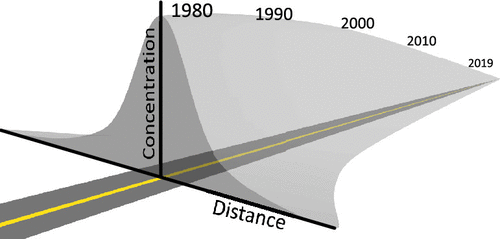当前位置:
X-MOL 学术
›
Environ. Sci. Technol.
›
论文详情
Our official English website, www.x-mol.net, welcomes your
feedback! (Note: you will need to create a separate account there.)
Four Decades of United States Mobile Source Pollutants: Spatial–Temporal Trends Assessed by Ground-Based Monitors, Air Quality Models, and Satellites
Environmental Science & Technology ( IF 10.8 ) Pub Date : 2021-01-05 , DOI: 10.1021/acs.est.0c07128 Lucas R F Henneman 1 , Huizhong Shen 2 , Christian Hogrefe 3 , Armistead G Russell 2 , Corwin M Zigler 4
Environmental Science & Technology ( IF 10.8 ) Pub Date : 2021-01-05 , DOI: 10.1021/acs.est.0c07128 Lucas R F Henneman 1 , Huizhong Shen 2 , Christian Hogrefe 3 , Armistead G Russell 2 , Corwin M Zigler 4
Affiliation

|
On-road emissions sources degrade air quality, and these sources have been highly regulated. Epidemiological and environmental justice studies often use road proximity as a proxy for traffic-related air pollution (TRAP) exposure, and other studies employ air quality models or satellite observations. To assess these metrics’ abilities to reproduce observed near-road concentration gradients and changes over time, we apply a hierarchical linear regression to ground-based observations, long-term air quality model simulations using Community Multiscale Air Quality (CMAQ), and satellite products. Across 1980–2019, observed TRAP concentrations decreased, and road proximity was positively correlated with TRAP. For all pollutants, concentrations decreased fastest at locations with higher road proximity, resulting in “flatter” concentration fields in recent years. This flattening unfolded at a relatively constant rate for NOx, whereas the flattening of CO concentration fields has slowed. CMAQ largely captures observed spatial–temporal NO2 trends across 2002–2010 but overstates the relationships between CO and elemental carbon fine particulate matter (EC) road proximity. Satellite NOx measures overstate concentration reductions near roads. We show how this perspective provides evidence that California’s on-road vehicle regulations led to substantial decreases in NO2, NOx, and EC in California, with other states that adopted California’s light-duty automobile standards showing mixed benefits over states that did not adopt these standards.
中文翻译:

美国四个十年的移动源污染物:通过地面监测器、空气质量模型和卫星评估的时空趋势
道路排放源会降低空气质量,这些排放源受到严格监管。流行病学和环境正义研究经常使用道路邻近度作为交通相关空气污染(TRAP)暴露的代理,其他研究则采用空气质量模型或卫星观测。为了评估这些指标再现观察到的近路浓度梯度和随时间变化的能力,我们将分层线性回归应用于地面观测、使用社区多尺度空气质量 (CMAQ) 的长期空气质量模型模拟和卫星产品。 1980年至2019年间,观察到的TRAP浓度下降,道路邻近度与TRAP呈正相关。对于所有污染物而言,距离道路较近的地点浓度下降最快,导致近年来浓度场“平坦”。 NO x的平坦化以相对恒定的速率展开,而 CO 浓度场的平坦化速度减慢。 CMAQ 很大程度上捕获了 2002 年至 2010 年观察到的 NO 2时空趋势,但夸大了 CO 与元素碳细颗粒物 (EC) 道路邻近度之间的关系。卫星测量的氮氧化物浓度夸大了道路附近的浓度降低情况。我们展示了这种观点如何提供证据,证明加利福尼亚州的道路车辆法规导致加利福尼亚州的 NO 2 、NO x和 EC 大幅减少,而其他采用加利福尼亚州轻型汽车标准的州与未采用加利福尼亚州轻型汽车标准的州相比,显示出不同的效益这些标准。
更新日期:2021-01-19
中文翻译:

美国四个十年的移动源污染物:通过地面监测器、空气质量模型和卫星评估的时空趋势
道路排放源会降低空气质量,这些排放源受到严格监管。流行病学和环境正义研究经常使用道路邻近度作为交通相关空气污染(TRAP)暴露的代理,其他研究则采用空气质量模型或卫星观测。为了评估这些指标再现观察到的近路浓度梯度和随时间变化的能力,我们将分层线性回归应用于地面观测、使用社区多尺度空气质量 (CMAQ) 的长期空气质量模型模拟和卫星产品。 1980年至2019年间,观察到的TRAP浓度下降,道路邻近度与TRAP呈正相关。对于所有污染物而言,距离道路较近的地点浓度下降最快,导致近年来浓度场“平坦”。 NO x的平坦化以相对恒定的速率展开,而 CO 浓度场的平坦化速度减慢。 CMAQ 很大程度上捕获了 2002 年至 2010 年观察到的 NO 2时空趋势,但夸大了 CO 与元素碳细颗粒物 (EC) 道路邻近度之间的关系。卫星测量的氮氧化物浓度夸大了道路附近的浓度降低情况。我们展示了这种观点如何提供证据,证明加利福尼亚州的道路车辆法规导致加利福尼亚州的 NO 2 、NO x和 EC 大幅减少,而其他采用加利福尼亚州轻型汽车标准的州与未采用加利福尼亚州轻型汽车标准的州相比,显示出不同的效益这些标准。











































 京公网安备 11010802027423号
京公网安备 11010802027423号